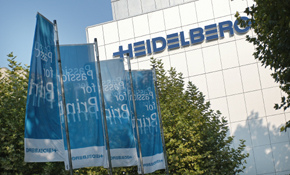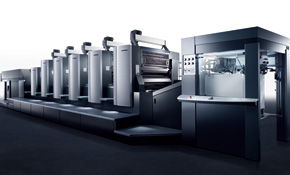
Charles Babbage, the 19th century computing pioneer, once made the far-sighted pronouncement that “errors using inadequate data are much less than those using no data at all”.
Imagine what Babbage would make of today’s data-driven world and the modern-day incarnations of his ‘Difference Engine’, the mechanical calculator he conceived in 1822, which is seen as the precursor of today’s computer.
In the 21st century, data and databases lie at the heart of pretty much every imaginable interaction. And it seems the opportunities to analyse and learn from these data are becoming more powerful and sophisticated on an almost daily basis.
Perhaps it was inevitable that in this connected world, it would only be a matter of time before printing presses became connected in new ways too. Not in the sense of ‘distribute-then-print’ model some people have been using for years. For this article, we are talking about a performance connection. The sort of connection whereby sophisticated real-time data gathering allows printers to see how their presses are performing compared with their peers around the globe.
That is the promise of Heidelberg’s Prinect Performance Benchmarking (PPB) system. This concept was previewed at Ipex in May 2010 and Heidelberg began rolling it out in Europe in earnest just over three months ago, with early adopters overseas able to sign up to use the facility free of charge (a payment system is expected in 2012).
The system will hit our shores soon. Soeren Lange, product manager of Prinect & CTP at Heidelberg Australia and NZ, expects a local release by the first quarter of 2012, though early adopters might get a glimpse before the year is out.
So what’s it all about? Imagine, if you will, a giant secure server somewhere in Heidelberg (the city), Germany. At the moment, more than 100 latest-generation Heidelberg presses – in use at customers all around the world – are connected to it and the server is collecting data about how these presses are running: how fast they are printing, what the uptime is and the overall press performance.
Worldwide peer group
When it launches, local users who opt in to the PPB system will be able to see, via a simple internet browser interface, how their press or presses are performing against a peer group of similar users in the Australia. Or Germany. Or Greece. Or the US. Or indeed, see how their press performance is stacking up compared with users in the whole world.
This stuff has the potential to be addictive. Like checking an ex-partner’s relationship status on Facebook, but far more useful and hopefully less detrimental to one’s mental health.
Heidelberg explains the tool as “performance benchmarking”. The presses deliver performance data into a central server, for example, makeready times, operational hours and waste. On a daily basis, PPB reports back: the average situation every day, then the average of every month. This allows the pressroom manager to compare against the averages being hit by comparable printers.
Customers have to formally opt in to
the programme and give Heidelberg permission to download data. Users fill in an application form, then Heidelberg’s German technicians access the press remotely and place what could be described as an ‘app’ on the press control system. Once the press is re-booted, PPB is active. Users are provided with login and password details to access their data.
One caveat is that older presses can’t be linked up to the system. “It would only be the newer presses,” says Lange.
“You need a certain press console version to run this benchmarking tool – one with a network connection. There is certain ‘cut-off’ version. Technically you could bring some older, pre-2010 presses up to the latest version, but that’s not always commercially viable.”
This will somewhat limit the tool’s potential in Australia – for now. The number of late-model Speedmasters in ANZ is still a far cry from the bevy of top-spec machines found across western Europe and the UK, says Lange. Plenty of Aussies printers have had cold feet for investment during the GFC. But with many presses now a generation or two behind, and with Drupa coming up, it can only be a matter of time before local firms are forced into a buying decision.
Another potential roadblock to widespread uptake of PPB is whether users feel comfortable about having their data downloaded to a giant brain in another country. “An accidental data loss by Heidelberg could be very beneficial to another company,” muses one Heidelberg user in the UK, who had decided not signed up for the scheme.
In response, Heidelberg points to the level of data security required by law in Germany, which is far more robust than in lots of other countries.
Lange says the service is totally anonymous. “The printer will be able to compare his press with say, a press in Germany or China but he doesn’t know who he is compared against. Typically, the comparison is against a couple of hundred presses; you can’t just compare yourself with the printer next door. You are comparing yourself to your competitors eventually, but it is completely anonymous.”
Data on tap
So far, the UK and Germany are hot spots for early adopters of the PPB system. For instance, 18 presses in the UK are already hooked up to it. It is still early days for PPB on a global scale, but it is clear that the more people who join in, the more accurate the data will become.
So what will users actually see? Upon logging in, customers can specify a reference group against which they want to compare their performance data. This is not set in stone and can be changed on an ad-hoc basis. Through simple drop-down menu options, users can choose to limit their group to certain countries, and/or to certain types of printing: book, folding box, label or commercial. Alternatively the reference group could be all presses of this type everywhere in the world without defining a particular product speciality.
A series of bar charts are then displayed showing press performance based on five different formulas. They are: average good speed production, which is the mean speed during the printing of good sheets; a speed index during production of both good and waste sheets; a quality index showing the mean amount of good sheets produced; a time index showing how much time the press is actually producing during the periods it is switched on; and finally an chart combining those elements in terms of Overall Equipment Efficiency (OEE).
While OEE is a commonly used term in Europe, it has yet to gain much currency in our local market. But when it comes to analysing the performance of machinery, it is the ultimate measurement. Lange explains that OEE is the combination of all the parameters above: speed, quality and time.
“Quality is how many good sheets you have produced, as a percentage of all the sheets on the floor. If you have to run 10,000 sheets to get 8,000 good sheets, your quality is not so good. The same goes with time: of the total available uptime on the press, how long have you spent to produce good sheets?”
Then there’s speed – OEE is a fair comparison between a new supercharged press and an older generation machine that can’t put as many sheets on the floor.
“If your press runs at a maximum of 15,000 sheets per hour (sph) and you are running at 13,000sph, that gives you an index of 80% of maximum speed. Compare that to a press capable of running at 18,000sph that is also running at 13,000sph,” says Lange.
Speed-wise, both presses are putting the same number of sheets on the floor, but in terms of OEE, the higher-spec press would only running at 72%.
Comparing different machines, whether across different versions, different regions or different applications, is the promise of the PPB system. When a user looks at each chart on the PPB system, they’ll see coloured lines that highlight the peer group average, the individual company’s own personal average, and the average performance of the peer group leader or best in class. And if the company is itself the peer group leader, this is highlighted.
Power in your hands
All of these options will be open to Australian Heidelberg customers once the service is up and running here. For those printers with the in-house aptitude to juggle complex data, Lange says PPB puts power in their hands. But if they need support to act on the data, this is where the supplier can step in with its business consultancy offering.
When it is officially launched in Australia, expect PPB to be bundled in with Heidelberg’s extensive services offering. Lange points out that collecting the data is only half the battle – it is the making analysis and taking action that requires real analytical oomph.
While the benchmarking aspect of the PPB system is new, this level of data collection is not. Lange explains that OEE reporting is part of Pressroom Manager, a module of Prinect. This tool sits in front of the press collecting data and can generate the OEE report locally. If a printer is not willing to share his data with the world, he still has the ability to get access to detailed data on how he is running, and can hook into Heidelberg’s consultancy service if he needs advice.
Lange is keen on cross-selling the PPB system with the consultancy offering. “It is actually easy to generate the data. This tool does not give recommendations: it is just a data tool. It just says, this is how many sheets you have done and this is how many others have done, to tell you if you are above or below the average.”
While Australia is behind Europe in the launch of PPB, the local Heidelberg arm is out in front in other areas, says Lange.
“From the point of view of business consultancy, in Australia we have always been ahead of the game. The whole consultancy idea was created here a few years back. What Heidelberg is rolling out globally, we have done for five or six years.”
The reasoning behind combining PPB with more traditional consultancy services is that Heidelberg will collect shopfloor data, crunch the numbers then make recommendations, such as how to improve efficiencies.
Before you assume this will just become an elaborate way to shift more heavy metal, Lange stresses that the conclusion of the exercise won’t necessarily be a nudge toward buying a top-spec Speedmaster.
“The recommendation doesn’t automatically mean we want to sell a machine. This service is about maintaining and cementing relationships – and improving them of course.”
Rival set-ups
This begs the question, what are competitors doing in this space? Surprisingly for a high-tech nation like Japan, it seems that Komori doesn’t have anything comparable. Or, if it does, it isn’t available outside of Japan yet.
Heidelberg’s German compatriots, KBA and Manroland, do have systems that allow press performance data to be analysed, although not on the sort of country or worldwide group-review basis provided by the Prinect system.
“KBA Logotronic Professional captures data from the press, and allows customers to assign different parameters and customise it to the information they want. So Printer A doesn’t have to have the same definitions as Printer B,” explains KBA Australasia’s general manager, sheetfed presses, Dave Lewis.
“The difference is we don’t report it into a central database because the definitions differ from business to business. We believe every account is different, so it’s not really possible to have true comparisons. Customers are unique, they all have a unique set-up,” adds Lewis.
Manroland also focuses its system on a customer’s individual requirements. The Integration Pilot Plus tool takes info from the press and records all the actions on the press such as makeready, good sheets, wash up, etc. It also logs time for ‘undefined events’, so if the machine is stationary the operator specifies why, for example waiting for plates or paper.
This information can be fed back into a printing company’s own MIS or used for further analysis with Manroland’s Pre Act consultancy service. This includes monthly OEE reports allowing users to identify weak points in their operation and find the potential for improvement. Although this is not compared against a peer group, Manroland does set a benchmark for each press.
So, depending upon the press supplier, the options are individual performance stats versus the potential to compare with other printing companies from Townsville to Timbuktu. It will be fascinating to see what the uptake is for Heidelberg’s Prinect system come the end of the year.
“It’s so exciting and there are so many possibilities to evaluate,” says Lange. “Selling presses and equipment is not enough anymore. It’s about providing consultation and information that helps people improve.”
In such a hyper-competitive environment, any system that helps printing company owners derive greater insights about the performance of their business, and about how to improve it, must surely be welcomed.
With the sort of foresight that comes with genius, Charles Babbage had something to say in 1864 that is as relevant today as it was then: “Whenever a man can get hold of numbers, they are invaluable: if correct, they assist in informing his own mind, but they are still more useful in deluding the minds of others. Numbers are the masters of the weak, but the slaves of the strong.”
Comment below to have your say on this story.
If you have a news story or tip-off, get in touch at editorial@sprinter.com.au.
Sign up to the Sprinter newsletter


